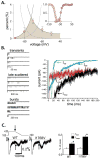Pathophysiology of the cardiac late Na current and its potential as a drug target
- PMID: 22198344
- PMCID: PMC3816394
- DOI: 10.1016/j.yjmcc.2011.12.003
Pathophysiology of the cardiac late Na current and its potential as a drug target
Abstract
A pathological increase in the late component of the cardiac Na(+) current, I(NaL), has been linked to disease manifestation in inherited and acquired cardiac diseases including the long QT variant 3 (LQT3) syndrome and heart failure. Disruption in I(NaL) leads to action potential prolongation, disruption of normal cellular repolarization, development of arrhythmia triggers, and propensity to ventricular arrhythmia. Attempts to treat arrhythmogenic sequelae from inherited and acquired syndromes pharmacologically with common Na(+) channel blockers (e.g. flecainide, lidocaine, and amiodarone) have been largely unsuccessful. This is due to drug toxicity and the failure of most current drugs to discriminate between the peak current component, chiefly responsible for single cell excitability and propagation in coupled tissue, and the late component (I(NaL)) of the Na(+) current. Although small in magnitude as compared to the peak Na(+) current (~1-3%), I(NaL) alters action potential properties and increases Na(+) loading in cardiac cells. With the increasing recognition that multiple cardiac pathological conditions share phenotypic manifestations of I(NaL) upregulation, there has been renewed interest in specific pharmacological inhibition of I(Na). The novel antianginal agent ranolazine, which shows a marked selectivity for late versus peak Na(+) current, may represent a novel drug archetype for targeted reduction of I(NaL). This article aims to review common pathophysiological mechanisms leading to enhanced I(NaL) in LQT3 and heart failure as prototypical disease conditions. Also reviewed are promising therapeutic strategies tailored to alter the molecular mechanisms underlying I(Na) mediated arrhythmia triggers.
Copyright © 2011 Elsevier Ltd. All rights reserved.
Figures




Similar articles
-
Ranolazine improves abnormal repolarization and contraction in left ventricular myocytes of dogs with heart failure by inhibiting late sodium current.J Cardiovasc Electrophysiol. 2006 May;17 Suppl 1(Suppl 1):S169-S177. doi: 10.1111/j.1540-8167.2006.00401.x. J Cardiovasc Electrophysiol. 2006. PMID: 16686675 Free PMC article.
-
Molecular basis of ranolazine block of LQT-3 mutant sodium channels: evidence for site of action.Br J Pharmacol. 2006 May;148(1):16-24. doi: 10.1038/sj.bjp.0706709. Br J Pharmacol. 2006. PMID: 16520744 Free PMC article.
-
A computational modelling approach combined with cellular electrophysiology data provides insights into the therapeutic benefit of targeting the late Na+ current.J Physiol. 2015 Mar 15;593(6):1429-42. doi: 10.1113/jphysiol.2014.279554. J Physiol. 2015. PMID: 25545172 Free PMC article.
-
The role of late I Na in development of cardiac arrhythmias.Handb Exp Pharmacol. 2014;221:137-68. doi: 10.1007/978-3-642-41588-3_7. Handb Exp Pharmacol. 2014. PMID: 24737235 Free PMC article. Review.
-
Role of late sodium channel current block in the management of atrial fibrillation.Cardiovasc Drugs Ther. 2013 Feb;27(1):79-89. doi: 10.1007/s10557-012-6421-1. Cardiovasc Drugs Ther. 2013. PMID: 23108433 Free PMC article. Review.
Cited by
-
Multi-scale Modeling of the Cardiovascular System: Disease Development, Progression, and Clinical Intervention.Ann Biomed Eng. 2016 Sep;44(9):2642-60. doi: 10.1007/s10439-016-1628-0. Epub 2016 May 2. Ann Biomed Eng. 2016. PMID: 27138523 Free PMC article.
-
Exploring mutation specific beta blocker pharmacology of the pathogenic late sodium channel current from patient-specific pluripotent stem cell myocytes derived from long QT syndrome mutation carriers.Channels (Austin). 2022 Dec;16(1):173-184. doi: 10.1080/19336950.2022.2106025. Channels (Austin). 2022. PMID: 35949058 Free PMC article.
-
Dynamics of the late Na(+) current during cardiac action potential and its contribution to afterdepolarizations.J Mol Cell Cardiol. 2013 Nov;64:59-68. doi: 10.1016/j.yjmcc.2013.08.010. Epub 2013 Sep 6. J Mol Cell Cardiol. 2013. PMID: 24012538 Free PMC article.
-
ICaL and Ito mediate rate-dependent repolarization in rabbit atrial myocytes.J Physiol Biochem. 2018 Feb;74(1):57-67. doi: 10.1007/s13105-017-0603-z. Epub 2017 Dec 14. J Physiol Biochem. 2018. PMID: 29243206
-
Chronic Mexiletine Administration Increases Sodium Current in Non-Diseased Human Induced Pluripotent Stem Cell-Derived Cardiomyocytes.Biomedicines. 2024 May 29;12(6):1212. doi: 10.3390/biomedicines12061212. Biomedicines. 2024. PMID: 38927420 Free PMC article.
References
-
- Coraboeuf E, Deroubaix E, Coulombe A. Effect of tetrodotoxin on action potentials of the conducting system in the dog heart. Am J Physiol. 1979;236(4):H561–7. - PubMed
Publication types
MeSH terms
Substances
Grants and funding
LinkOut - more resources
Full Text Sources
Other Literature Sources

